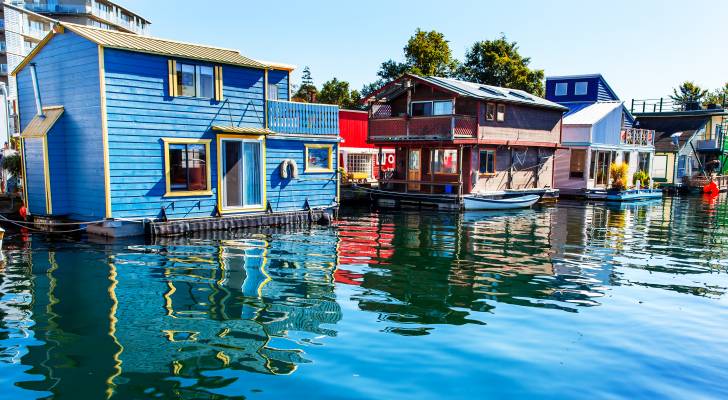
Wayne and Kathy Paquette thought they’d found the perfect retirement plan: a sleek floating home on the water, no property tax, no snow to shovel, and a fraction of the cost of a traditional house. They paid $265,000 to a man named Joe Nemins from a company called Live on The Bay.
No home was ever delivered.
“I thought, ‘Wow, I can actually retire,’” Wayne said. “We were excited. It all sounded so good.”
Their floating home was supposed to be finished last May, but they say there were delays and it was never completed. Now, the Paquettes have lost their life savings.
“We have been taken advantage of,” said Kathy. “And we have lost our life savings.”
They’re not alone. At least three customers allege they were duped by the same company.
Ronda Kemp, who moved from Alberta to Midland, Ontario, to be closer to family, handed over $165,000. “I would like my money back, but I don’t think that’s going to happen,” she told CTV News “I worked all my life… now I have nothing to show for it.”
Jim Lewis, another buyer, paid $350,000 for a two-story floating house that was due to be delivered in July 2024. Lewis is frustrated as it appears the builder just abandoned the project. "We are now left to our own devices," he said to CTV, to sort out a floating home that was never completed.
Why this matters for first-time homebuyers
What happened to these buyers is more than a sad story — it’s a warning.
Canada’s housing market has pushed many first-time buyers to the brink. With soaring prices and interest rates, even entry-level homes are increasingly out of reach. According to the Canadian Real Estate Association, the average home price in Canada in early 2025 hovers near $700,000. In cities like Toronto and Vancouver, it’s closer to $1 million.
For younger buyers, the dream of homeownership is slipping further away. So they look for alternatives: Fixer-uppers, tiny homes, off-grid properties, and floating homes.
But desperation makes you vulnerable. And that’s the trap.
The promise of something affordable can be used against you. That’s why it’s critical to protect yourself — not just from scams, but from risky mortgages that leave you house-poor or overleveraged.
How to avoid getting burned: Tips for a smart, affordable mortgage
Get pre-approved and understand your budget
Before shopping for any home, talk to a mortgage advisor or bank about what you can realistically afford — and ask for multiple scenarios (fixed vs. variable, rate hikes, job loss). Don’t just go by what you can borrow. Know what you can safely afford.
Compare mortgage types
Fixed-rate mortgages offer stability, but variable-rate options may start lower. Make sure you know how your payments could change if rates increase — because they might.
Avoid private or unregulated lenders unless absolutely necessary
If a deal seems too easy or fast, ask why. Stick with lenders governed by federal or provincial rules, which offer consumer protections.
Build in a buffer
Don’t max out your budget. Leave room for rising interest rates, maintenance, or unexpected job changes. The rule of thumb: Housing costs should stay under 30% to 35% of your gross income.
Watch out for red flags
Unclear contracts, pushy sellers, or “can’t-miss” investment pitches are signs to walk away. Do your research. Ask for references. Consult a real estate lawyer before signing anything non-traditional.
Consider co-buying or shared ownership
If you can’t buy solo, co-ownership agreements with trusted friends or family are becoming more common — just make sure the legal agreements are solid.
Are alternative housing options the future?
Canadians across the country are struggling with affordable housing and as a result alternative housing options are on the rise. This makes alternatives, such as the floating homes appealing. With a floating home you own the structure and can choose to keep it in the water and pay moorage fees — similar to condo fees — or use a tugboat or similar vessel to move it to another water-based location.
Floating homes gained popularity in expensive cities, such as Vancouver and Toronto, as it was a way to stay close to big-city amenities without assuming a $1 million mortgage.
But floating homes are not the most popular alternative housing option. By far the most accessible option is a tiny home. The Ontario government defines a “tiny home” as being a standalone, self-contained structure that includes a living/dining area, bathroom, sleeping area and kitchen. Tiny homes are cheaper to build and maintain than a regular house. Depending on zoning laws in your city or district, you can add a tiny home to your property or look for tiny home zoning in your city’s master building plan.
Another option are modular homes. These homes are built using prefabricated pieces. They’re made offsite and then delivered to a property and assembled onsite. Like a regular house, these are stand-alone homes that offer all the regular modern conveniances, such as electrical and plumbing. The biggest difference is that a modular home is faster to erect than a stick-framed house — reducing the amount of time it takes between purchase and moving into your brand new home.
Next steps for the Ontario floating home buyers
When CTV News reached out to Joe Nemins, he explained in a phone interview that he had completed his part of the work and pointed the finger at the three customers for the delays. According to him, the customers changed their plans mid-construction, causing setbacks.
The cases are now part of an ongoing investigation involving lawyers and police.
Bottom line
The Paquettes’ story is heartbreaking, but it’s also a wake-up call. In this market, being hopeful isn’t enough. You need to be informed, protected, and ready to walk away from anything that seems too good to be true — even if it floats.
Sources
1. CTV News: Customers who bought ‘dream’ floating home say it’s become a nightmare (Jan 21, 2025)
This article provides information only and should not be construed as advice. It is provided without warranty of any kind.


